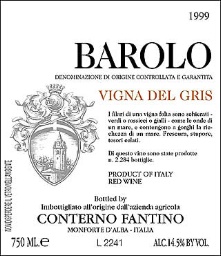
External search
Google (images)
Wine Advocate
Wine Spectator
Burghound
Wine-Searcher
Vintages
2020
2019
2018
2017
2016
2015
2014
2013
2012
2011
2010
2009
2008
2007
2006
2005
2004
2003
2002
2001
Show more
From this producer
Show all wines
All tasting notes
|
| Drinking Windows and Values |
| Community Tasting History |
| By Antonio Galloni
Vinous, 1999 Barolo: Brilliance, Intensity and Class (Aug 2014) (11/1/2012)
(Conterno-fantino Barolo Vigna Del Gris) Subscribe to see review text. | By Antonio Galloni
Vinous, Barolo 1999: The Forgotten Vintage (May 2006)
(Conterno-fantino Barolo Vigna Del Gris) Subscribe to see review text. | By Stephen Tanzer
Vinous, November/December 2002, IWC Issue #105
(Conterno Fantino Barolo Vigna del Gris) Subscribe to see review text. |
NOTE: Scores and reviews are the property of Vinous. (manage subscription channels) |
| Conterno Fantino Producer website
It is rare among the individualistic personalities that exist in the Langhe Hills to find two young winemakers with such a strong willingness to work together. In 1982, at the tender age of 18, Claudio Conterno and family partnered with Guido Fantino (ex- cellar master at Prunotto and another young rising star) to form the Conterno-Fantino estate. The nucleus of their efforts was cru Ginestra, which grew to include Vigna del Gris located on the same hilltop in the commune of Monforte d’Alba (known for austere, structured Barolos). Early ambitions incorporated the traditional approach set by their parents. But in 1985 the duo decided to experiment with a Nebbiolo/Barbera blend in what is now the legendary Super Piemonte, Monprà, which included the use of barrique. In 1994 they built a state-of- the-art winery in the Bricco Bastia area where they brought innovation and technology to the Nebbiolo vines they had mastered. The pair remains at the forefront of advancement in quality winemaking, and they firmly believe that vigilant viticultural practices are the essence of great wine.
NebbioloNebbiolo is a red grape indigenous to the Piedmont region of Italy in the Northwest. The grape can also be found in other parts of the world, though they are not as respected.
Nebbiolo is often considered the "king of red wines," as it is the grape of the famed wines of Barolo DOCG, Barbaresco DOCG, and Roero DOCG. It is known for high tannins and acidity, but with a distinct finesse. When grown on clay, Nebbiolo can be very powerful, tannic, and require long aging periods to reach its full potential. When grown on sand, the grape exhibits a more approachable body with more elegant fruit and less tannins, but still has high aging potential.
"Nebbiolo" is named for the Italian word, "nebbia", which means "fog", in Italian and rightfully so since there is generally a lot of fog in the foothills of Piedmont during harvest.
Nebbiolo is a late-ripening variety that does best in a continental climate that boasts moderate summers and long autumns. In Piedmont, Nebbiolo is normally harvested in October.
More links:
Varietal character (Appellation America) | Nebbiolo on CellarTrackerItaly Italian Wines (ItalianMade.com, The Italian Trade Commission) | Italian Wine Guide on the WineDoctorPiedmont Vignaioli Piemontesi (Italian only)
On weinlagen-infoLanghe Consorzio di Tutela Barolo Barbaresco Alba Langhe e Roero | Union of Producers of Albese Wines (Albeisa)BaroloRegional History:
The wines of Piedmont are noted as far back as Pliny's Natural History. Due to geographic and political isolation, Piedmont was without a natural port for most of its history, which made exportation treacherous and expensive. This left the Piedmontese with little incentive to expand production. Sixteenth-century records show a mere 14% of the Bassa Langa under vine -- most of that low-lying and farmed polyculturally. In the nineteenth century the Marchesa Falletti, a frenchwoman by birth, brought eonologist Louis Oudart from Champagne to create the first dry wines in Piemonte. Along with work in experimental vineyards at Castello Grinzane conducted by Camilo Cavour -- later Conte di Cavour, leader of the Risorgimento and first Prime Minister of Italy -- this was the birth of modern wine in the Piedmont. At the heart of the region and her reputation are Alba and the Langhe Hills. This series of weathered outcroppings south of the Tanaro River is of maritime origin and composed mainly of limestone, sand and clay, known as terra bianca. In these soils -located mainly around the towns of Barolo and Barbaresco -- the ancient allobrogica, now Nebbiolo, achieves its renowned fineness and power.
map of Barolo DOCG
An interesting thread on Traditional vs. Modern Barolo producers:
https://www.wineberserkers.com/forum/viewtopic.php?f=1&t=106291 |
|




